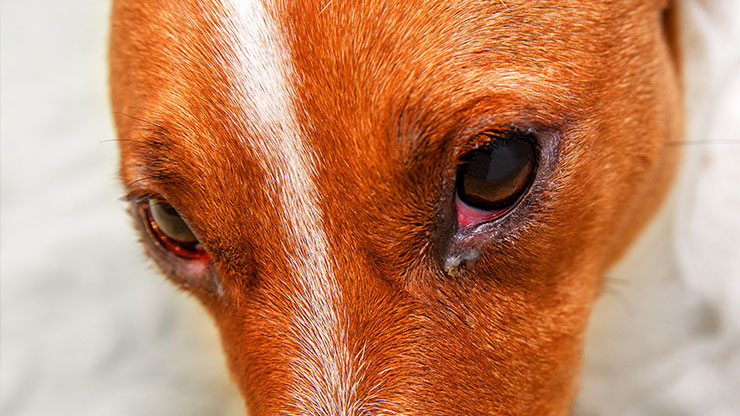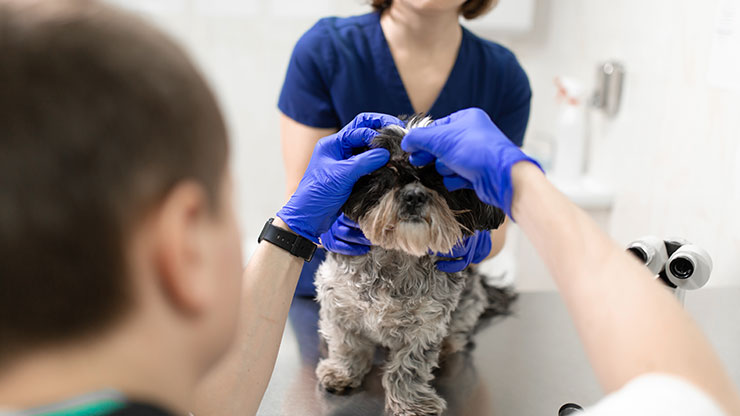
Treating Dog Eye Infections: Symptoms, Causes, and Prevention
Eye infections are quite common in dogs and can occur due to various causes such as bacteria, viruses, or even injuries. An eye infection is an inflammatory response that results in redness, swelling, and discharge in a dog's eye. Recognizing these infections early and seeking appropriate treatment can significantly affect your dog's comfort and overall eye health.
What are the Most Common Types of Dog Eye Infections?
There are various types of dog eye infections. These include canine conjunctivitis, allergic conjunctivitis, viral eye infections, bacterial eye infections, and fungal eye infections.
Canine conjunctivitis: Canine conjunctivitis is the inflammation of the conjunctiva, the lining that protects the eye globe and eyelids. While it can develop from bacterial and viral infections, conjunctivitis refers to inflammation and irritation rather than the cause. Conjunctivitis can be secondary to another problem affecting the eye.
Allergic conjunctivitis: This type of eye condition can be triggered by an allergic reaction to environmental substances such as pollen or grass. Symptoms may include pinkish eyes, sneezing, and a tear or other discharge from the eyes.
Viral eye infections: Dogs can suffer from viral diseases that affect the eyes, such as distemper or canine herpes virus.
Bacterial eye infections: Bacterial eye infections usually cause a sticky green/yellow eye discharge, which can spread to the other eye and other dogs. Common environmental bacteria can infect the eyes; some diseases can manifest as eye infections. Bacteria can also penetrate the eye through injury or trauma.
Fungal eye infections: Fungi from the environment can affect a dog's eyes, leading to inflammation.
What Causes Dog Eye Infections?
Dog eye infections can arise from various sources. They often result from allergies to environmental elements such as pollen, dust mites, or mold. Injuries play a role, too; an accidental scratch or incidents where the eyes come into contact with harmful substances, like certain shampoos, can lead to infections. Furthermore, foreign objects, a simple speck of dirt or bits of metal, glass, or wood, can harm the eye's surface, creating a gateway for bacterial infections. Non-infectious conditions, such as cataracts, uveitis, and glaucoma, may cause symptoms similar to an eye infection.

Signs and Symptoms of Dog Eye Infections
What does a dog eye infection look like? Here are dog eye infection symptoms and signs to look for:
- Inflammation and redness
- Excessive tearing Blinking
- Itchiness; pawing at the eye or rubbing on the ground.
- Abnormal eye discharge
- Treatment Options for Dog Eye Infections
Prevention and Management of Dog Eye Infections
Most eye infections require medical help, but there are ways to avoid them. Regular cleanliness is fundamental. By using a clean cloth or pet-friendly eye wipe, you can gently cleanse around your dog's eyes, eliminating potential irritants. When it comes to bath time or the application of topical treatments, exercise caution to ensure no products enter your dog's eyes, as these can induce irritation.
It's not uncommon for dogs to develop allergies. If you've noticed signs of allergic reactions, minimizing their exposure to potential allergens becomes crucial, given that allergies can often pave the way for eye infections. After outdoor excursions or stays in dusty environments, inspecting your dog's eyes for foreign objects like dirt or grass is a good practice.
Regular veterinary checkups are invaluable. A routine visit allows doctors to detect early indicators of eye issues or infections. Remember, your dog's overall health is vital in warding off infections. A balanced diet complemented by regular exercise goes a long way in keeping your canine companion healthy.
Lastly, it's wise to be vigilant about their interactions. If you know another dog battling an eye infection, keeping your pet at a distance is best until the affected dog recovers.

How Long Do Dog Eye Infections Take to Heal?
The duration of healing for a dog eye infection can vary greatly depending on the type, severity, and how promptly it is treated. Generally, with proper veterinary care and medication, mild bacterial or viral eye infections can start to improve within a few days and may fully resolve within 1-2 weeks. However, more severe or complicated infections may take several weeks or even longer to heal. Some conditions, like chronic dry eye, may require ongoing management.
When Are Dog Eye Infections Serious?
An eye infection in a dog can become severe if they show signs of pain, produce excessive eye discharge, are unable to open their eyes, demonstrate a lack of energy, or exhibit a fever. In such instances, your dog must receive immediate veterinary attention.
Conclusion
Always keep a close watch on your dog's eye health. Recognizing common eye infections, their causes, and symptoms allows for prompt treatment and better outcomes.
-----

About the Author
Dr. Laura Fontana is a licensed and accredited veterinarian who provides virtual vet consultations to BetterVet customers. Dr. Fontana earned her DVM from Virginia-Maryland College of Veterinary Medicine in 2009. She completed an equine sports medicine internship and divided her time between equine and small animal ambulatory practice until 2014 when she started Signature Veterinary Services. From 2014-2023, she owned and operated Signature Veterinary Services, a full-service, mobile small animal practice based out of San Diego, before joining the BetterVet team.










